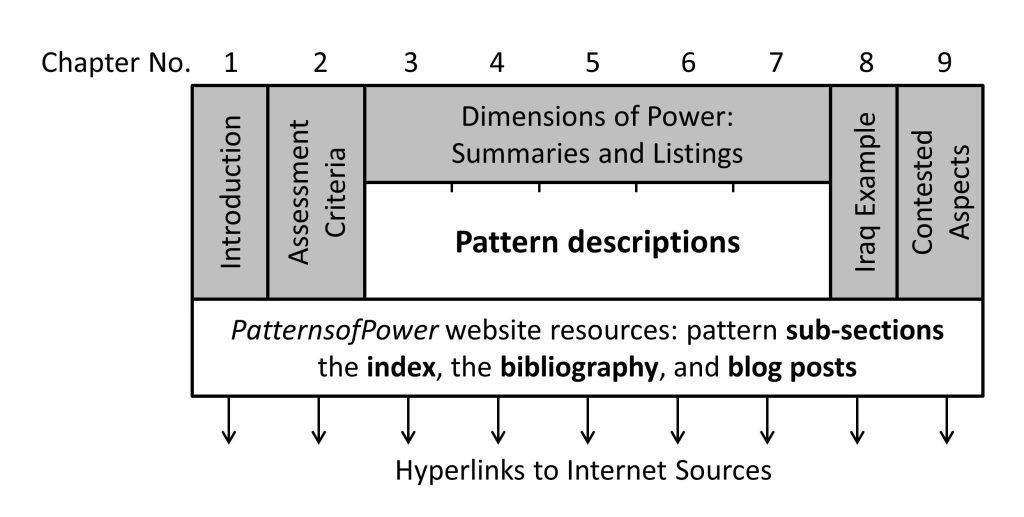Description of chapter structures
This description of chapter structures also explains the relationship between chapters and describes different ways of reading the books.
There are two books: the Overview and the Summary. The diagram below (which is not to scale) illustrates the shape of the books and their relationship to the rest of the website:

The shaded area of this diagram corresponds to the contents of the Overview book. This short book aims to give readers a broad understanding of the project. It also acts as a route map to where information is stored.
The Summary book also contains the pattern descriptions (but not their sub-sections).
Chapter 2, Assessment Criteria, summarises the way in which power is classified and judged by its acceptability to those who are subject to it. The chapter finishes with a worked example of these books’ method of analysis.
The five dimensions of power are then described in the following chapters: 3. Economic Power; 4. Moral Influence; 5. Legal Powers; 6. Political Authority; 7. Ungoverned Power. They have similar chapter structures:
Each begins with an overview segment, summarising the nature of that dimension of power, followed by an explanation of the way in which it has been divided into numbered segments. In the Summary book, at the end of each overview, a link is provided to the following chapter – so that readers can choose to gain an overview of the whole book before drilling down into any pattern descriptions.
Each segment has its own contents list, linking to the numbered sections into which it has been divided: the pattern descriptions. Each section is a brief stand-alone essay which describes a pattern of power. They include examples of recent experience, arguments which are commonly associated with them, and the views of some other commentators.
Some of these, such as foreign policy in the political chapter, are very big subjects. These have been further analysed into sub-sections, which are linked to from the associated pattern descriptions and from the index. They contain further reference material which is not included in the Summary book. It is anticipated that these will be changed more frequently than the pattern descriptions that they are attached to.
The numbering is hierarchical, in the form (chapter.segment.section.sub-section). Foreign policy, for example, is (6.7.7) because Political Authority is in chapter 6; complex issues are listed in segment 7 of that chapter; and the section on foreign policy is the 7th pattern description in that segment. Sub-sections have a fourth layer of numbering, so (6.7.7.1) describes coercive foreign policies. These numbers in brackets are hyperlinked in electronic versions of the books. They are used to form links between different aspects of complex subjects.
Each segment, section, and sub-section is provided with a Back button, to go to the previous level in the hierarchy, and a Next button for readers who want to read sequentially – as at the bottom of this section.
These five chapters constitute a survey of the patterns of power in today’s world: categorising, clarifying, and assessing how power is used. The Summary book contains the pattern descriptions, but the Overview book only contains a summary of the contents of each segment followed by a listing of the pattern descriptions.
Chapter 8 analyses the decision to invade Iraq, which prompted the realisation that a more rigorous analysis of power was needed – as described in the Preface. It therefore provided an appropriate illustration, and a test, of how the book’s approach works. It is only included in summary form in current issues of the book, which link to archive material.
Chapter 9 draws upon the earlier material, to provide further analysis of some contentious issues. It identifies where continual renegotiation is needed, and it highlights some opportunities for improving governance. It also provides evidence that the individual components of acceptability are all achievable with goodwill.
The Universal Declaration of Human Rights (UDHR) is included as Appendix 1, for convenience when reading the books offline.
The Bibliography provides Internet hyperlinks where these are available.
The Index contains hyperlinks to sections and sub-sections of the books, and to categories and tags of the blog posts, for readers of electronic versions.
Endnotes identify the Internet source material used, in the paper versions of the book, but the electronic versions use hyperlinks.
Footnotes on some pages are used for references that are not online, and additional explanation where this might be useful.
The Internet references were live at the time of writing. They provide quick access for readers of electronic formats of this book who are online, so that news articles and speeches can be read in their entirety.
The book will hopefully be updated and improved as readers comment and offer further relevant material. Emails to editor@patternsofpower.org will be welcomed.
This description of chapter structures is intended to form part of Edition 4 of the Patterns of Power series of books. An archived copy of it is held at https://www.patternsofpower.org/edition04/Structure-b.htm